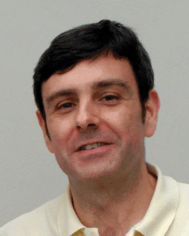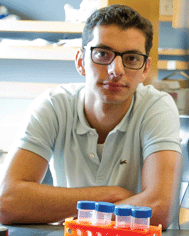Biological Insights from Synthetic Biology
Jordi
Garcia-Ojalvo
a,
Ahmad S.
Khalil
b and
John
McCarthy
*c
aDepartment of Experimental and Health Sciences, Universitat Pompeu Fabra, 08003 Barcelona, Spain
bBiomedical Engineering Department, Boston University, Boston, MA 02215, USA
cSchool of Life Sciences, University of Warwick, Coventry, CV4 7AL, UK. E-mail: john.mccarthy@warwick.ac.uk
It is a great pleasure to introduce this Integrative Biology themed issue on Synthetic Biology. The articles featured here cover a refreshingly diverse range of themes. Indeed, they are a testament to the truly exciting breadth of innovative research being pursued by synthetic biologists. Synthetic biology represents a powerful approach to increasing our understanding of the organization and function of biological systems found in nature. Moreover, the tools and techniques being developed are enabling unprecedented manipulation and measurement of biological systems. Guided by these natural blueprints and new techniques, researchers are considering where synthetic biology can (and should) go, both in application space as well as in design space. How can these fundamentally new technologies be applied to address important societal problems? How do we use synthetic biology to systematically explore, define, and expand the functional space of biological systems? Effectively venturing into these spaces will require a better appreciation of fundamental uncertainties and constraints in biology. This highlights the unique way in which the engineering approach of synthetic biology provides added impetus, as well as new methods, to develop an ever more accurate and quantitative appreciation of the principles underpinning living systems.
This themed issue starts off by examining fundamental challenges in the strategies and technologies of synthetic biology. Manzoni et al. (DOI: 10.1039/C5IB00274E) review the principles governing the ways in which synthetic biologists have built genetic circuitry, considering the differences between biological and electronic circuits. Advancing technology, for example in the domain of DNA synthesis and assembly and methods such as CRISPR, is facilitating circuitry construction. However, the authors encourage us to address the challenges facing the implementation of circuitry designs, such as limited scalability and complex interactions with the host organism. It is essential that these problems are overcome since otherwise they will continue to constrain the scope of synthetic biology research. In a complementary article, Lindle and Dunlop (DOI: 10.1039/C5IB00286A) discuss how library-based approaches can complement rational design approaches to the construction and optimisation of DNA circuitry and metabolic pathways. Computational modelling based on a competitive growth equation can be used to illustrate how synthetic systems can respond effectively to changing environmental conditions. This is a useful way to understand how different constraints may need to be traded off against each other in the pursuit of optimisation. The authors deliver a strong argument for coupling evolution-guided design to the more standard synthetic construction processes.
In general, it seems that more discussion of constraints and uncertainties in biology is key to advancing this discipline. Zhang et al. (DOI: 10.1039/C5IB00275C), for example, enumerate three broad sources of uncertainty for the design of genetic circuits in living cells: (i) an incomplete quantitative characterization of components that make up a genetic circuit, (ii) unknown/unintended interactions of the circuit with the host “chassis”, and (iii) the inherent randomness (noise) associated with cellular processes. The authors offer solutions for either addressing the uncertainties, e.g. choosing network motifs that are inherently more resistant to the effects of noise, or embracing the uncertainties, e.g. competitive interactions between circuit and host components can result in useful phenotypes and dynamics. Taking this theme further, synthetic biology can be used to increase our understanding of biological processes from a systems-level perspective. It does so by simplifying biological phenomena through their bottom–up redesign using minimal components. This enables the identification of the fundamental elements of a given process, and their quantification. This approach is reviewed by Wang et al. (DOI: 10.1039/c5IB00252D), through examples of synthetic reconstitution of minimal mechanisms of multistable, stochastic, oscillatory, and pattern forming dynamics in bacteria. Ciechonska et al. (DOI: 10.1039/c5IB00271K) extend the discussion to mammalian cells, focusing especially on their intracellular and extracellular organization. Synthetic biology also enables us to address the question of how the different parts that build a biological system work together to produce the vast array of behaviours that characterize a living system. In that way, according to Vincent et al. (DOI: 10.1039/C5IB00321K), it bridges the gap between the approaches of geneticists and biochemists, which are respectively devoted to identifying the parts and their interrelationships, and to building systems from these component parts. Vincent et al. review recent efforts in that direction addressed towards establishing the way in which developmental enhancers work.
Garcia et al. (DOI: 10.1039/C6IB00006A) discuss a series of case examples through which synthetic biology converts cells into “test tubes”, in which theoretical hypotheses can be tested. This resembles efforts made for instance in physics, where “synthetic quantum devices” have been developed which reveal fundamental quantum properties that are usually non-existent in nature due to their stripped-down simplicity. Garcia et al. present the lac operon in E. coli as the “hydrogen atom” of bacterial transcriptional regulation, in which a synthetic biology approach enables careful quantitative analysis. Other examples include reconstituted circuits underlying bacterial competence and cis regulation in Notch–Delta signalling, hidden variables affecting decision making in the lambda phage, morphogen gradient reshaping in fruit fly development, and synthetic evolution in flies. Along the same lines of using synthetic biology to learn about living systems, Schikora-Tamarit et al. (DOI: 10.1039/c5IB00230C) propose a method to identify the existence of feedback regulation, whether positive or negative, in RNA binding proteins in yeast. The method is based on comparing the expression of these proteins (monitored via fluorescent reporters fused to the proteins of interest) under the control of an inducible promoter, to that of a reference protein. The strategy is further tested with synthetic feedback loops, in what constitutes another instance of the utility of synthetic approaches in fundamental biological research. A similar use of this strategy is presented by Dies et al. (DOI: 10.1039/C5IB00262A), who study how the cell cycle interacts with a synthetic oscillator in the bacterium E. coli, by comparing the effect of the influence exerted by periodic cell division on the oscillator, with a synthetic back-coupling from it into the cell-division regulation mechanism.
Turning to the applications of synthetic biology, Chakravarti et al. (DOI: 10.1039/C5IB00325C) argue that basic synthetic biology paradigms and tools are ready for translational “prime time”, specifically highlighting one of the most exciting therapeutic application spaces for synthetic biology: cancer immunotherapy. Here, synthetic biology has the potential to build on the early success of CAR T-cell therapy, which involves genetically engineering a patient's own T cells to express tumor-targeting receptors and delivering these engineered cells back into the patient to detect and eliminate cancer cells. Synthetic biology solutions can provide additional levels of control to fine-tune T-cell function and to incorporate safety features into these sometimes too powerful therapies, as well as to bring down their cost. Indeed, there is a lot of excitement and focus on cell-based therapies, harnessing the inherent sophistication of living cells as medicines. Beyond therapeutics, however, Dobrin et al. (DOI: 10.1039/C5IB00263J) argue that synthetic biology advances could serve as useful tools for biomedical science but have been largely underutilized by basic researchers. For example, synthetic tools and circuits make it possible to exhaustively investigate endogenous cellular systems, with interesting examples from transcriptional regulatory element design and receptor–ligand interactions. Moreover, novel sensors can enable the detection of intracellular species, like protein levels, in live cells without having to perform cell lysis (Western blots) or modify the target proteins. Finally, the ability to reconstruct components and pathways of dangerous pathogens can unlock pathogen-free cell-based screening for new drugs.
A fascinating challenge that promises to generate multiple applications is that of re-engineering the genetic code. Schwessinger et al. (DOI: 10.1039/C5IB00232J) provide a novel example of this in which the UAG codon in E. coli is recoded to direct the incorporation of sulfotyrosine into proteins in a strain that has had all of its amber stop codons replaced by UAA. Recoding of the amber codon is achieved by using a synthetic tRNA/aminoacyl-tRNA synthetase pair. The authors describe how they have produced a sulphated version of the RaxX60 protein and have used this to promote immune resistance in rice plants against the bacterial pathogen Xanthomonas oryzae. There is also a radically different way to take advantage of bacteria in synthetic biology; this involves their use as hosts for phages. Sagona et al. (DOI: 10.1039/C5IB00267B) review how genetically modified bacteriophages can potentially be used in a variety of applications, including pathogen detection and suppression, phage display, packaging of nanomaterials, and combatting agricultural infections. There are interesting possibilities for the utilization of phages in the future, but a number of practical challenges will need to be overcome before they can be widely used. This looks like a promising area of development that is worthy of more attention. As explained by de las Heras et al. (DOI: 10.1039/C5IB00310E), synthetic biology approaches to soil bacteria also promise to help us address major challenges posed by environmental pollution. The authors show how the regulatory architecture of Pseudomonas putida can be re-engineered to optimise the functionality of this organism in biodegradative treatments of pollutants such as m-xylene.
As we consider future applications, Ollé-Vila et al. (DOI: 10.1039/C5IB00324E) discuss synthetic biology beyond individual cells. Specifically, by merging ideas from synthetic biology, complexity, and tissue engineering, the authors provide a rubric for exploring and building organs and organoids, both to understand evolutionary and architectural constraints, and to advance regenerative medicine. Importantly, these efforts – which will involve engineering both cells and their environments – will need to consider so-called emergent phenomena and how these properties can be integrated with traditional (predictable) design in synthetic biology. Intriguingly, the authors map a diverse set of organs and organoids onto a so-called morphospace, a phase space representation defined by three “orthogonal” axes: physical state, developmental complexity, and cognitive complexity. This exercise reveals a large unexplored morphology space, which in the future could serve as a guide for exploring new design space not found in natural development and elucidating whether such solutions are constrained by development or altogether forbidden for more fundamental reasons. New technologies are being developed that allow synthetic biologists to explore the use of microenvironments to control gene expression and to engineer spatially differentiated expression profiles. Schwarz-Schilling et al. (DOI: 10.1039/C5IB00301F) report how picolitre-sized emulsion droplets can be utilized to introduce position-dependent effects or to accommodate cell-free expression systems. Such droplets allow chemical communication between the enclosed bacterial communities, as well as between enclosed cell-free systems and living bacteria. This promises to facilitate the construction of even quite complex artificially differentiated communities of synthetic systems. Finally, as synthetic biology ventures into unexplored application and design spaces, Porcar et al. (DOI: 10.1039/C5IB00239G) caution against freely applying metaphors, such as the widespread metaphor of organisms as “machines”. In fact, there is a key difference between machines and organisms – the purposiveness of machines is extrinsic (designed and maintained by a user) whereas the purposiveness of organisms is intrinsic (they work on their own). Ignoring this central difference, and all that comes with it, will most certainly constrain future efforts to engineer organisms. Instead, we must appreciate flexibility as a basic trait of biological systems and exploit what tasks cells have been at least partially designed to perform. Going forward, merging rational design with evolutionary approaches will represent a good approach to creating artificial designs that play well with “already-working” biological systems.
| This journal is © The Royal Society of Chemistry 2016 |



